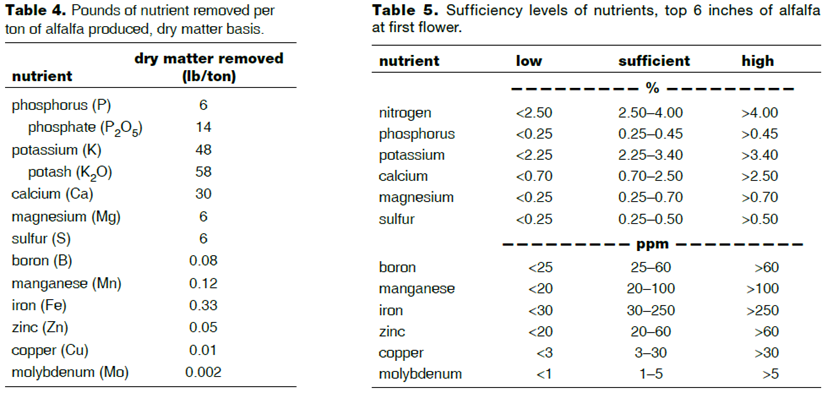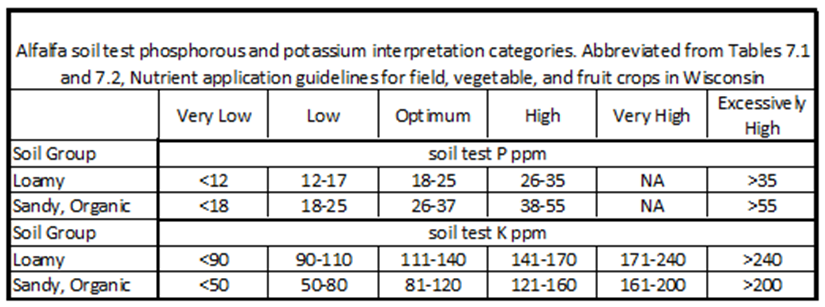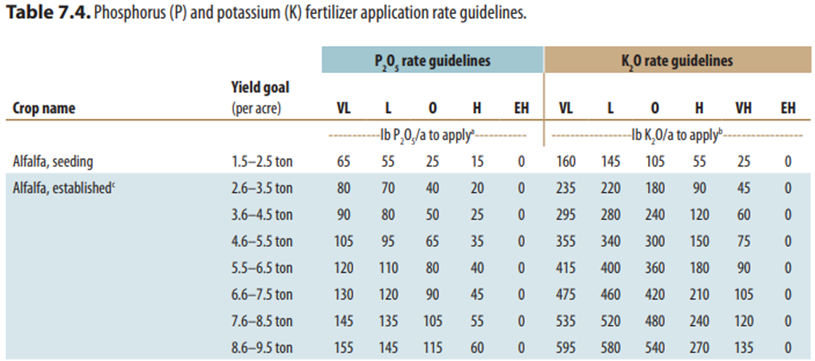Key Reminders as the Planting Season Finishes Up; Importance of a Strong Alfalfa Fertility Program
BY Dairyland Seed Agronomy Team
POST-EMERGENCE HERBICIDE APPLICATIONS
Your post emergence herbicide application plans should be in place, if not already being put into action. At this point, we hope that you have crafted a “systems approach” to weed control and that your post application strategy is just one piece in your overall management plan.
While major decisions, such as which herbicide products and application methods to use, have already been made, there are some important considerations that can still make or break the season. Korey Sutton, Corteva Crop Protection Territory Manager in Central Wisconsin, recently offered up some key reminders for this time of year. His first tip came with little hesitation, “More water in the tank is better. For example, pushing rates closer to 20 gpa versus 15 gpa will provide better coverage and efficacy, if applicable to the products you are applying.” While 15 gpa certainly helps us cover more acres on a fill, we need to consider the quality of our work in the long run.
“Know your weeds and what you are trying to control,” Sutton says next. This point strongly aligns with the broader consensus of the Dairyland Seed Agronomy Team -- scout more often! We need to scout ahead of time to know our target weeds and their size in order increase control. Sutton reminds us that this is a good opportunity to use a tool like Granular Insight’s Directed Scouting. “This tool really does help you prioritize your time and attention,” he adds. But we also need to utilize this pass across the field for broader scouting. Be sure to note areas of concern for later follow-up. If nothing else, a notebook in the cab during the month of June can be very valuable come October.
Lastly, double check the labels for the products you plan to use. Are they targeting the appropriate weeds? Do I have the appropriate rate in my plans? What are the appropriate tank cleaning recommendations? Sutton also emphasizes the importance of studying the product mixing sequence. “Confirming the sequence with a simple jar test can save lots of headache in the field. Nobody wants a clogged sprayer.”
While these operations are just part of the bigger picture during a growing season, we all know that one small chink in the chain can cause everything to tumble. Pay attention to detail and try not to cut corners this time of year. Your crop depends on it, and more importantly, so does your personal safety.
SIDE DRESS CONSIDERATIONS
As corn planting finishes in many parts of the Dairyland Seed footprint, side dress application of nitrogen will begin soon. There is no one-size-fits-all nitrogen management recommendation due to variables such as soil type, type of nitrogen fertilizer applied, application timing, etc.
When does nitrogen use peak in corn? On average, N use peaks in corn between V6 and R1 (silking) growth stages. Corn will accumulate 70 percent of nitrogen that it will need during this period. Nitrogen availability during this time is critical for corn growth and development. The nitrogen stored in the plant during vegetive growth is remobilized during maturity and can account for over half of the N found in the grain.
How much N to apply? The literal $1,000,000+ question. Nitrogen use efficiency in corn has definitely increased over the last 50 years as illustrated by the graph. Factors such as N products used, application timing, and efficiency of modern hybrids play a role in this increase in efficiency. As shown by the graph, 1.1 to 0.8 pounds of N are required produce a bushel of grain. It is important to note that the graph refers to total N applied to the corn crop, not just side dress application.
Pounds of N Applied/Bushel of Grain Produced

What about Nitrogen stabilizers? A nitrogen stabilizer is a product added to Nitrogen fertilizer that keeps the N in ammonium form for a longer period of time. The ammonium form of Nitrogen is not mobile in the soil, but through nitrification. Ammonium is turned to nitrate which is mobile in the soil and prone to leaching or denitrification. The two types of nitrogen stabilizers are urease inhibitors and nitrification inhibitors.
- Urease inhibitors are added to surface-applied nitrogen fertilizers to inhibit ammonia volitation or “gassing off”.
- Nitrification inhibitors are added to incorporated nitrogen fertilizers and work to inhibit the biological activities that turn ammoniacal nitrogen to nitrate which is mobile and prone to leaching through the soil profile.
Each of these additives work to keep the fertilizer where you put it and keep it available to the crop for a longer period of time.
Take note- Side dress is an excellent time to monitor different aspects of your corn crop.
- Herbicide efficacy: Were there any escapes from your herbicide application?
- Planter issues: Are there any discernable patterns such as skips or stand variations that can be linked to possible planter issues? Noting these issues now can help prevent them next year.
- Insect feeding: Above ground pest feeding can be obvious from a tractor cab, but abrupt changes in corn plant height can mean that pests are feeding below the soil surface. Often times damage from Asiatic garden beetle and other pests are noticed while side dressing.
ALFALFA FERTILITY 101
Profitable alfalfa crops are driven by yield, requiring a strong fertility program in order to achieve desirable regrowth throughout the growing season and store adequate root carbohydrates ahead of winter dormancy. Considering that one dry ton of alfalfa removes about 14lbs of P2O5 and 58lbs of K2O from the soil, most alfalfa fields are likely deficient in key nutrients that are restricting yield potential and stand longevity. With harvest season right around the corner, managing your alfalfa stand for peak performance starting with the first cutting will set that field up for success all summer long. Since the first crop of alfalfa taken off the field yields the most tons, it also means it takes the most nutrients out of the soil that need to be replenished in order to keep that field productive and thriving.
 Source: Alfalfa Management Guide, (A4075). 2015. University of Wisconsin-Extension, University of Minnesota-Extension, Iowa State University-Extension
Source: Alfalfa Management Guide, (A4075). 2015. University of Wisconsin-Extension, University of Minnesota-Extension, Iowa State University-Extension
- Review the basics by assessing alfalfa stand plant density before applying fertilizer to ensure that your field has enough yield potential to justify extra inputs. Be aware of the alfalfa dry matter that you removed in the previous year(s) and consider the fertilizer requirements necessary to not just maintain adequate fertility but what is needed to increase it. Farms that stick to providing high basic fertility levels over time have more success producing high levels of quality forage year after year.
- Soil tests are the best indicators of fertility needs, especially when combined with tissue samples early in the growth cycle. Waiting for plants to show visual signs of nutrient deficiency means you’ve already lost yield potential or could mis-diagnose symptoms as environmental factors. If you’re spreading or incorporating animal waste into your alfalfa fields, manure tests are vital to your nutrient management program. Don’t overlook this necessary component.
- It’s essential to be sure the major fertility components are at levels that promote high yields and high quality first before considering micronutrient needs. Unless N, P, and K are at sufficient levels in the soil and available to the plant, the additional products won’t make much of a difference and may simply be a waste of money.
- Alfalfa absorbs most nutrients in the top 6 to 8 inches of soil, making the form of application just as important. Work with your trusted agronomist to decide if topdressing or soil incorporation will work better for the product being used and whether the plant is able to mobilize that nutrient from the soil.
- With alfalfa’s symbiotic relationship with the nitrogen-fixing bacteria Rhizobium, additional Nitrogen applications are not necessary unless the field has not received adequate liming or the soil is light and dry in the seeding year. In these scenarios, 30-50 lb/acre of Nitrogen could boost productivity.
- Alfalfa needs relatively large amounts of phosphorus and potassium to support yield and decease disease susceptibility. These nutrients can also be relatively immobile when added directly to the soil, especially if the pH is not ideal. Applications of phosphate and potash need to be monitored closely since luxury consumption is possible and excess of these nutrients are undesirable for cattle feed. If tissue samples support the need for either of these, apply immediately following first cutting.
- With the increasing number of foliar diseases plaguing alfalfa, consider the use of a fungicide when heavy disease pressure is evident or a long cutting schedule is preferred. Analyze your cutting schedule, cost of product, hay value, and disease potential to make a final determination for each field.
- Apply a fertilizer after 1st cutting to help carry the stand through the season and then again after 3rd cutting to promote adequate levels going into winter. These split applications ensure proper nutrients are available all year round to maximize plant and soil health. Rate recommendations vary slightly by region or state but will lead to similar results. Identify your soil test categories in Tables 7.1 and 7.2, then find your annual fertilizer needs in Table 7.4.


Source: Nutrient Application Guidelines for Field, Vegetable and Fruit Crops in Wisconsin (A2809). 2012. Laboski and Peters
 |
 |
 |
 |
 |
| Brian Weller Western Region 507.456.3034 |
Dan Ritter Central Region 219.863.0583 |
Branden Furseth Northern Region 608.513.4265 |
Mark Gibson Eastern Region 260.330.8968 |
Amanda Goffnett Eastern Region 989.400.3793 |
